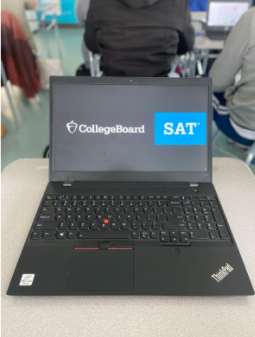Put Down Your Pencils, the SAT is Going Digital
July 10, 2022
A key part of the American high school experience is going digital, a change many are viewing with skeptical optimism.
The College Board recently announced that the SAT will go digital in the United States in 2024. The test will be shortened to just two hours instead of three, the “no calculator” section will see its termination. The reading passages will also be shortened and offered in a wider variety of topics.
This follows the transition to a “test-optional” model that many colleges adopted during the pandemic. When questioned about the test’s relevance moving forward, Joshua Landwehr, the weekend SAT test day coordinator and CRLS history teacher, told the Register Forum, “Many people feel they made the switch in order to be more relevant … they want to remain relevant and make more money.”
Landwehr cites an increase in testing days and easier access to accommodations, among other positives. He also brings up tech issues and cyber security as downsides. Landwehr mentioned ways test scores could be influenced, listing the device the student uses for the test and the amount of experience a student has with technology as likely limiting factors.
Student response to the change appears mostly positive. Senior Sarah Berhanu claimed to be “jealous of it in a way.” Freshman Areeba Khan said to the Register Forum, “I think for a lot of people it might lower the stress,” but Khan believes that the option for a paper test should still be available, claiming that not all students will do well with the digital format.
One such student is Junior Madison Hairston, who said that for “something as big as the SAT I think it’s something you should be able to do on paper. I would prefer to do it on paper.” Hairston is also worried about the transition to digital test taking, recalling the MCAS’s rough transition a few years ago, which came with a plethora of confusion and tech issues.
Senior Ciaran McNeely believes that “there should be a no calculator part in the test, as it demonstrates the more conceptual part of math.” McNeely does support the shortening in length, stating that “at some point you lose steam and you’re no longer graded on your knowledge but instead your stamina and mental fortitude.”
An aspect of the test that will likely not change, however, is the historical class and race bias. Senior Imran Hussain spoke about how preparing and studying for the SAT costs a lot of money and takes a lot of time. When asked what changes he’d like to see, he gave “making resources for standardized testing more accessible and finding some way to prevent the socioeconomic disparities that come with standardized test taking as a whole” as his top priority.
The College Board has received criticism for the test actively disadvantaging certain students, with Landwehr claiming that wealth, race, community, and other factors, are what actually determines a student’s score. He adds that “many people argue that this test is a way to level the playing field, but I don’t see it. I don’t.”
This piece also appears in our April 2022 print edition.









